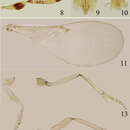Description
provided by Zookeys
Body length, including ovipositor, 0.72–1.1 mm. Frontovertex pale orange; orange in ocellar area, pale orange between occipital margin and posterior ocelli; immaculate from occiput to base of mandible; occiput with a large dark brown area above foramen, rest white; antenna (Fig. 8) with radicle very pale brown; scape mostly pale yellow and with a dark brown mark in middle, dorsal margin pale yellow; pedicel dark brown in proximal half, otherwise white, F1–F3 brown, F4–F6 white, clava dark brown, becoming slightly paler towards apex, apex pale brown; neck of pronotum brown, posterior margin translucent white, lateral spots relatively small and faint, rest white; dorsum of thorax orange; sides and posterior margin of mesoscutum and axillae inconspicuously bordered brown; setae translucent yellow, silvery in most lights; tegula white with apex pale grey-brown; metanotum orange; mesopleuron pale yellow; prosternum and mesosternum pale yellow; legs (Figs 12–14) mainly pale yellow; fore wing (Fig. 11) hyaline and with linea calva interrupted, stigmal vein about 2.3× as long as marginal vein, venation yellow-brown; hind wing hyaline; propodeum medially orange, laterally dark brown, sides white; gaster mostly yellow, sometimes pale brown dorsally from cercal plates to near apex, ovipositor sheath yellow.
Head with polygonally reticulate sculpture and mesh size slightly less than that of one eye facet; ocelli forming an acute angle less than 35°; eye not quite reaching occipital margin, separated by much less than diameter of a facet; frontovertex parallel-sided; scrobes shallow and U-shaped; antenna with scape about 2.7–3.5× as long as broad; funicle with F1–F4 smallest, subequal and transverse, F5 a little larger, F6 largest and slightly wider than long; linear sensilla only on F5 and F6; clava 3-segmented, its apex more or less rounded but with a short slightly oblique truncation; mandible relatively broad with three subequal, apical teeth; palpal formula 2-2 (Fig. 10), notaular lines reaching about 0.4× across mesoscutum; fore wing venation and setae as in Fig. 11; ovipositor (Fig. 9) slightly exserted, about 5.2× as long as ovipositor sheath.
Relative measurements: HW 13, FV 3, FVL 7, POL 2, AOL 4, OOL 1, OCL 2, POD 1, AOD 1.5, EL 8, EW 6, MS 3.5, SL 7, SW 2, FWL 37, FWW 14, HWL 26, HWW 5, OL 10, GL 2, MT 11.
Male. Length 0.7 mm. Generally similar to female but for coloration, structure of clava and genitalia. Frontovertex with ocellar area dark brown; dorsum of thorax and gaster dark brown. Antenna similar to that of female but clava solid and relatively slender; aedeagus about half as long as mid tibia.
- license
- cc-by-3.0
- copyright
- Ying Wang, Cheng-De Li, Yan-Zhou Zhang
- bibliographic citation
- Wang Y, Li C, Zhang Y (2013) A taxonomic study of Chinese species of the alberti group of Metaphycus (Hymenoptera, Encyrtidae) ZooKeys 285: 53–88
- author
- Ying Wang
- author
- Cheng-De Li
- author
- Yan-Zhou Zhang
Distribution
provided by Zookeys
China (Chongqing, Fujian, Guangdong, Sichuan, Zhejiang), Hawaii, USA (California), Costa Rica, South Africa, Swaziland, Australia.
- license
- cc-by-3.0
- copyright
- Ying Wang, Cheng-De Li, Yan-Zhou Zhang
- bibliographic citation
- Wang Y, Li C, Zhang Y (2013) A taxonomic study of Chinese species of the alberti group of Metaphycus (Hymenoptera, Encyrtidae) ZooKeys 285: 53–88
- author
- Ying Wang
- author
- Cheng-De Li
- author
- Yan-Zhou Zhang

